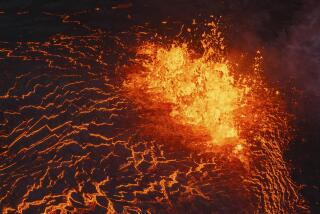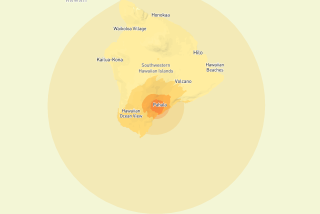Where to see dramatic lava flows from Hawaii Island’s Kilauea volcano

Watching the lava flow to the sea
The Kilauea volcano on Hawaii Island began erupting almost three months ago. To see the extraordinary lava flows firsthand, boat and helicopter tours are the way to go.
By boat
Boat tours offer views of red-hot lava hitting the ocean.
“To see the lava enter the sea is a special occurrence in nature that compares to nothing else in the world,” Capt. Shane Turpin of Lava Ocean Tours said in an email. The company is one of the Hilo-based boat operators that provide lava-viewing cruises.
“Our most popular tour is our sunrise tour that leaves at 4 a.m. It is the only guaranteed tour of the day that sees lava in the dark,” he added.
Three-hour, round-trip tours cost $250.
Is it safe to go? Several passengers aboard a Lava Ocean Tours boat were injured July 16 when a so-called “lava bomb” ripped through the roof during a sailing. Witnesses described the projectile as a piece of hot, hardened lava the size of a basketball.
Since the incident, the U.S. Coast Guard has ordered tour boat operators to stay at least 984 feet from the coastline.
By helicopter
Aerial viewing is another way to watch the molten drama unfold.
“It’s hard to describe. You almost get chicken skin just looking at it,” said Joel Van Brunt, the chief operating officer of Paradise Helicopters. Van Brunt has piloted roughly 50 tours over the lava flow since Kilauea began erupting May 3.
“It’s one of those moments where it’s hard to talk, it’s hard to articulate,” he added.
Paradise, one of the helicopter tour operators, provides a variety of lava-viewing flights from airports at Hilo and Kona. The trips from Hilo, which are far closer to the volcanic action, start at $170 for a half-hour tour sold exclusively to Costco members. A 45-minute tour available to all costs $274.
Given the longer flying time, tours from the Kailua-Kona area, nearer the island’s large resorts, cost $559 to $599 per person and last about two hours.
Aerial tours also fly along the coast, where streams of red-hot lava plunge into the much-cooler water of the Pacific Ocean.
By land
You can’t currently view the lava flow from land. About two-thirds of Hawaii Volcanoes National Park, which used to provide excellent volcano viewing prior to May, remains closed due to the ongoing eruption and frequent earthquakes.
“It’s mesmerizing. It’s overwhelming. It’s an amazing, historic event,” the pilot Van Brunt said. “But at the same time … you know there’s been close to 700 structures destroyed. So there’s a little bit of conflict internally.”
How long will the volcano spew lava?
The July 15 report by the U.S. Geological Survey’s Hawaii Volcanoes Observatory said the eruption could continue for a couple of years.
“If the ongoing eruption maintains its current style of activity at a high eruption rate, then it may take months to a year or two to wind down,” the report concluded.
“That statement is based on Kilauea’s history of past eruptions,” geologist Janet Babb said. “We’re looking at past eruptions in this area [known as] the Lower East Rift Zone.”
Lava continues to flow at a startling pace from a crack in the earth called Fissure 8. With more than 26,000 gallons of red hot, molten rock spewing out every second, the fissure’s flow is enough to fill an Olympic-size swimming pool every 25 seconds.
You can monitor daily activity on the volcano at Hawaii Volcanoes National Park’s website.
ALSO
‘Animal House’ turns 40. In Oregon, a toga party is planned. Off campus
Palm Springs tram reopens after four-day closure because of the Cranston fire
More to Read
Sign up for The Wild
We’ll help you find the best places to hike, bike and run, as well as the perfect silent spots for meditation and yoga.
You may occasionally receive promotional content from the Los Angeles Times.






